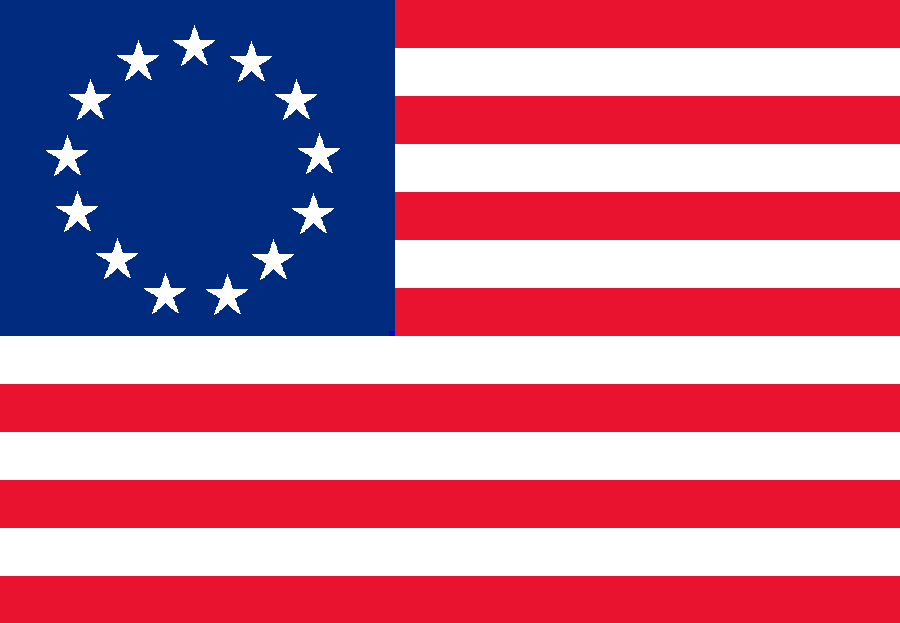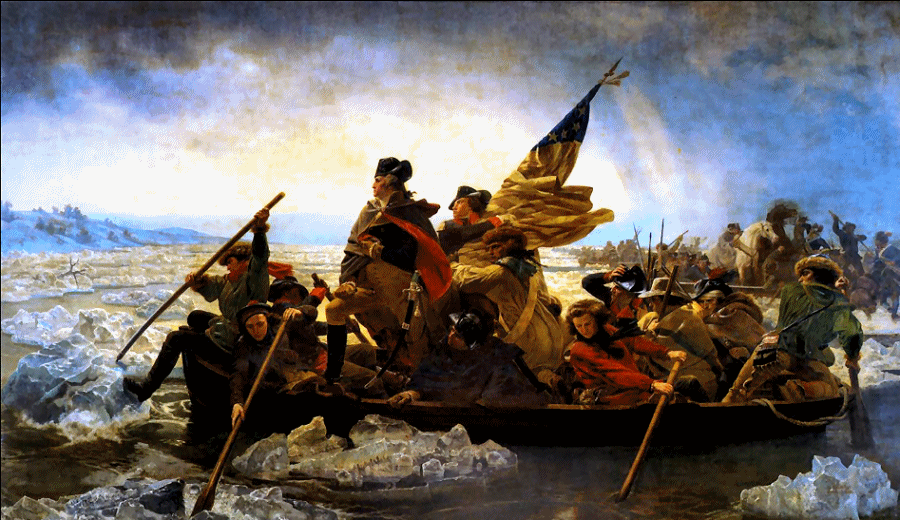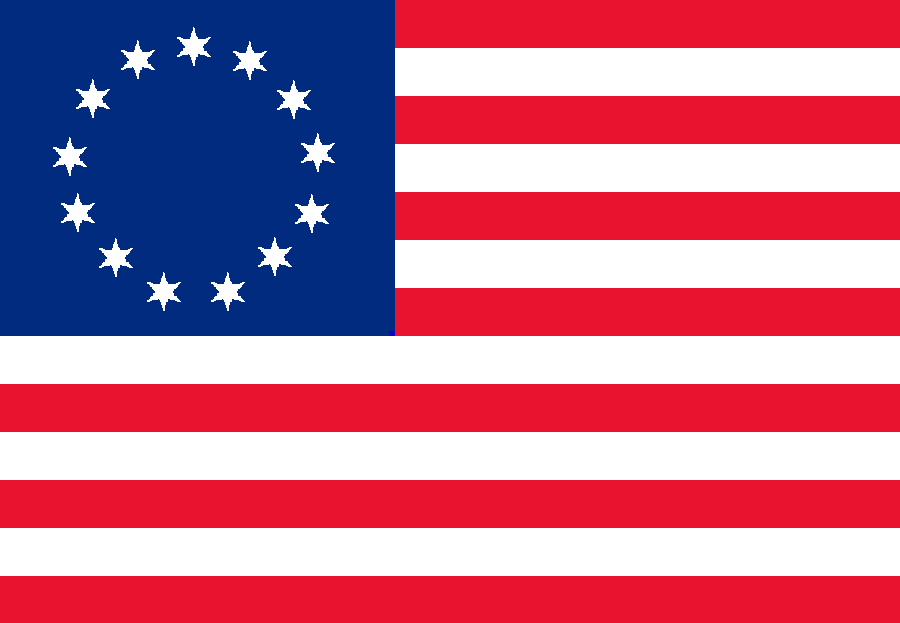


 During the 14 June 1777 session of the Second Continental Congress, a resolution was passed in which it was resolved: "That the flag of the ||thirteen|| United States be thirteen stripes, alternate red and white: that the union be thirteen stars, white in a blue field, representing a new constellation." This flag, with the thirteen stars in a circle~ representing a new constellation ~ is the design that many historians claim to have been the result of the Continental Congress' resolution of 14 June 1777. According to a 1913 publication by the Pennsylvania Society of the Sons of the Revolution: The Standards Flags And Banners of the Pennsylvania Society of Sons of the Revolution, this flag was first carried by Patriots at the battle at Cooch's Bridge, near Wilmington, Delaware on 03 September 1777. It was again seen on the field of battle at Brandywine, in Chester County, Pennsylvania, on 11 September 1777.
During the 14 June 1777 session of the Second Continental Congress, a resolution was passed in which it was resolved: "That the flag of the ||thirteen|| United States be thirteen stripes, alternate red and white: that the union be thirteen stars, white in a blue field, representing a new constellation." This flag, with the thirteen stars in a circle~ representing a new constellation ~ is the design that many historians claim to have been the result of the Continental Congress' resolution of 14 June 1777. According to a 1913 publication by the Pennsylvania Society of the Sons of the Revolution: The Standards Flags And Banners of the Pennsylvania Society of Sons of the Revolution, this flag was first carried by Patriots at the battle at Cooch's Bridge, near Wilmington, Delaware on 03 September 1777. It was again seen on the field of battle at Brandywine, in Chester County, Pennsylvania, on 11 September 1777.
 This flag is the epitome of the Patriot flag from the Colonial Period. It is the one, consisting of a field of thirteen, alternating red and white stripes on which was a canton of thirteen five-point stars on a blue background, that people commonly call the Betsy Ross Flag.
This flag is the epitome of the Patriot flag from the Colonial Period. It is the one, consisting of a field of thirteen, alternating red and white stripes on which was a canton of thirteen five-point stars on a blue background, that people commonly call the Betsy Ross Flag.
 This flag is the Stars And Stripes that is shown famously in the center of the painting, General George Washington Crossing The Delaware At The Battle Of Trenton On Christmas Night 1776, by Emmanuel Leutze. Despite being at odds with the fact that, as noted above, the flag was the result of the Flag Resolution of 14 June 1777, the flag, with its circle of stars made a nice impression in Leutze's famous painting.
This flag is the Stars And Stripes that is shown famously in the center of the painting, General George Washington Crossing The Delaware At The Battle Of Trenton On Christmas Night 1776, by Emmanuel Leutze. Despite being at odds with the fact that, as noted above, the flag was the result of the Flag Resolution of 14 June 1777, the flag, with its circle of stars made a nice impression in Leutze's famous painting.
 This flag also appeared in the study for the painting, George Washington at Trenton by Charles Wilson Peale, although that work of art is not well known by most people.
This flag also appeared in the study for the painting, George Washington at Trenton by Charles Wilson Peale, although that work of art is not well known by most people.

General George Washington Crossing The Delaware At The Battle Of Trenton On Christmas Night 1776.
Emmanuel Leutze, Painting 1851.
This image maintained by the Metropolitan Museum of Art, New York City, New York.
 In some cases, this flag is titled Stripes And Stars primarily due to the order in which the Congress described it, stating the thirteen stripes first, followed by the stars on a blue field for the canton. This would not be an incorrect way to title it, because most flags are described by stating the field first, followed by a description of the canton.
In some cases, this flag is titled Stripes And Stars primarily due to the order in which the Congress described it, stating the thirteen stripes first, followed by the stars on a blue field for the canton. This would not be an incorrect way to title it, because most flags are described by stating the field first, followed by a description of the canton.
 It should be noted that, although the generally accepted version of this flag's canton bears a circle of stars which are five-pointed, it was perhaps more often depicted with six-pointed stars. Charles Willson Peale painted this flag more often with six-point stars than five-point stars. Peale, like Trumball, served as an officer in the Continental Army and drew his inspiration from the regimental colours he personally saw during his service.
It should be noted that, although the generally accepted version of this flag's canton bears a circle of stars which are five-pointed, it was perhaps more often depicted with six-pointed stars. Charles Willson Peale painted this flag more often with six-point stars than five-point stars. Peale, like Trumball, served as an officer in the Continental Army and drew his inspiration from the regimental colours he personally saw during his service.

 The popular legend that Betsy Ross 'created' the first flag because of a personal request from George Washington has, in recent years, been proven to be just that ~ a legend. William J. Canby and George Canby, grandsons of Betsy Ross 'revealed', in 1870, just prior to the Centennial of the Nation's birth, that the General had asked their ancestor to make the first stars and stripes flag. The fact of the matter was that, although Elizabeth Ross had been engaged by the State Navy Board of Pennsylvania to sew flags ~ ships colors, there is no evidence that she was contacted by George Washington in regard to designing and/or sewing any flag to serve as the symbol of the new nation. George Washington's letters and other writings have been transcribed and fill thirty-seven 500+ page volumes. George Washington was extremely meticulous about preserving his correspondence and personal memoranda; if he had ever contacted Mrs. Ross, or anyone in fact, to design and make a flag, he would surely have noted such in his personal writings. There is no mention or inclusion of any correspondence or memoranda within those volumes regarding the flag and/or Elizabeth/Betsy Ross. The mystique of Betsy Ross and her creation of the nation's first flag was questioned almost immediately. Only two years later, George H. Preble questioned the veracity of the story in his book, Our Flag: Origin And Progress Of The Flag Of The United States Of America. Despite the doubt that surrounds the truth of the legend, this version of the Stars And Stripes flag continues to be lovingly called the Betsy Ross Flag and even simply as the Betsy Ross.
The popular legend that Betsy Ross 'created' the first flag because of a personal request from George Washington has, in recent years, been proven to be just that ~ a legend. William J. Canby and George Canby, grandsons of Betsy Ross 'revealed', in 1870, just prior to the Centennial of the Nation's birth, that the General had asked their ancestor to make the first stars and stripes flag. The fact of the matter was that, although Elizabeth Ross had been engaged by the State Navy Board of Pennsylvania to sew flags ~ ships colors, there is no evidence that she was contacted by George Washington in regard to designing and/or sewing any flag to serve as the symbol of the new nation. George Washington's letters and other writings have been transcribed and fill thirty-seven 500+ page volumes. George Washington was extremely meticulous about preserving his correspondence and personal memoranda; if he had ever contacted Mrs. Ross, or anyone in fact, to design and make a flag, he would surely have noted such in his personal writings. There is no mention or inclusion of any correspondence or memoranda within those volumes regarding the flag and/or Elizabeth/Betsy Ross. The mystique of Betsy Ross and her creation of the nation's first flag was questioned almost immediately. Only two years later, George H. Preble questioned the veracity of the story in his book, Our Flag: Origin And Progress Of The Flag Of The United States Of America. Despite the doubt that surrounds the truth of the legend, this version of the Stars And Stripes flag continues to be lovingly called the Betsy Ross Flag and even simply as the Betsy Ross.

